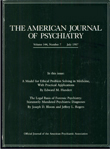An MRI study of the corpus callosum in autism
Abstract
OBJECTIVE: The purpose of this study was to examine the size of subregions of the corpus callosum in autistic individuals. METHOD: The areas of three subregions (anterior, body, and posterior) of the corpus callosum were examined on midsagittal magnetic resonance images of 35 autistic subjects whose mean age was 18 years and 36 healthy comparison subjects matched on age and IQ. RESULTS: After controlling for total brain volume, gender, and performance IQ, the authors detected a significantly smaller size of the body and posterior subregions of the corpus callosum in the autistic individuals. CONCLUSIONS: In the context of recent reports of increased brain size in autism, several possible mechanisms are considered in exploring the significance of a smaller relative size of the corpus callosum in autism.



